Having a slight amount of algae in your fish tank isn’t necessarily a bad thing. You see, wherever there is a combination of light and water, you’re likely to see some algae development. It’s natural, and it’s not something that any level of intervention can get rid of entirely. However, once that algae starts growing en masse? Things get a little troublesome. No one wants an aquarium plagued with algae, especially since it’s a sign of an imbalance present. That begs the question of, if you do begin noticing some unfortunate developments, how one should go to get rid of algae in a fish tank.
Sure, you could always turn to the market of available algaecides. There are plenty that are known to be effective. But they only go so far and last for so long. Algae grow in such rapid sequences due to underlying issues. These issues, unfortunately, aren’t problems that storebought chemicals can provide the answers for. Besides, you don’t want to introduce potentially harmful substances into your tank’s fragile ecosystem. Instead, you should concentrate on the natural solutions that work to get rid of the algae and also solve your tank’s core issue. We will discuss exactly that in this article.
What Is Algae?
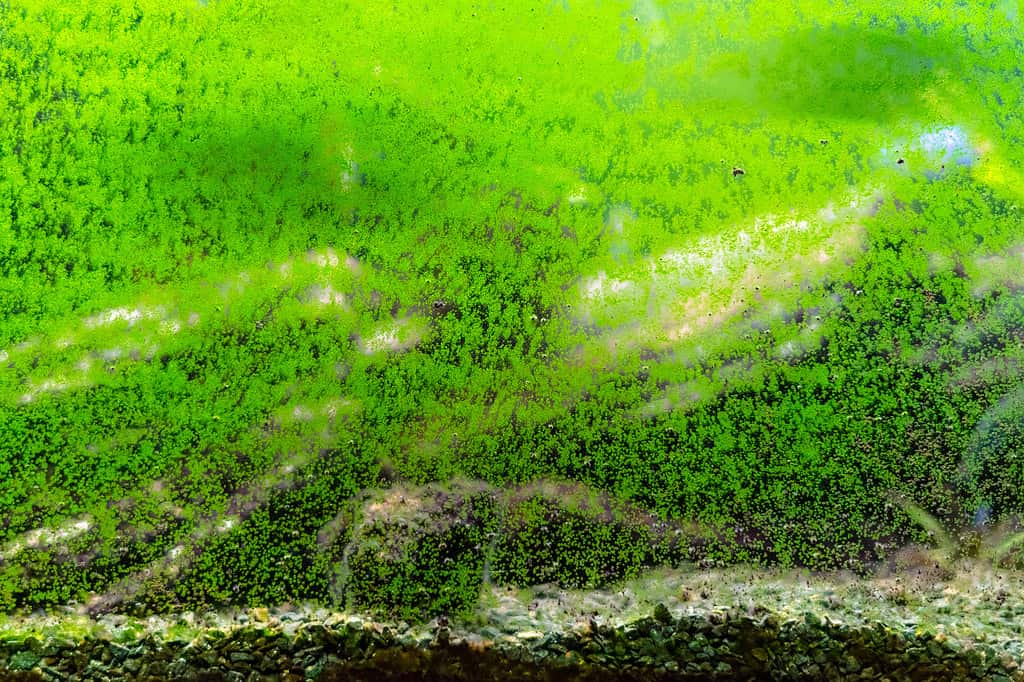
In the wild, algae play an important role as a primary producer of nutrients and oxygen.
©Ja’Crispy/iStock via Getty Images
Algae is something that falls into its own category entirely. It’s not exactly a plant because it doesn’t require the same complex growth conditions. They photosynthesize like plants but require far less light and can consume things that plants would have no use for. That’s why it grows so quickly- it doesn’t need much to do so.
Algae is found in a diverse array of habitats, primarily because it has a way of living regardless of its environment. It can exist as unicellular, multicellular, or colonial organisms. The role that algae play, especially in the wild, is as a primary producer that converts sunlight (through photosynthesis) into complex and energy-rich compounds. It also aids in oxygen production and nitrogen fixation, making it useful in its own right.
But that’s in the wild. Processes like oxygen production don’t need to be handled in a controlled area like your home because you’re there to provide necessary services for your aquatic life. Algae can be an eyesore, and it also has the potential to build in unflattering ways. That’s why so many concentrate on trying to get rid of algae in their fish tank; It simply doesn’t belong.
Algae Growth Causes
Algae grow for a number of reasons, but mostly, it’s caused by some sort of imbalance within your aquarium. The plants in your tank, of course, require certain levels of light and nutrients to grow properly. If there is an excess of something, whether that be food, light, or bacteria, algae use it as a source for growth. Since having a tank that is perfectly balanced is nearly impossible, stopping algae growth is nearly impossible. The overarching goal, then, should not be to get rid of the algae in your fish tank entirely but rather minimize the growth as best as you can.
The Most Common Types of Algae in Fish Tanks
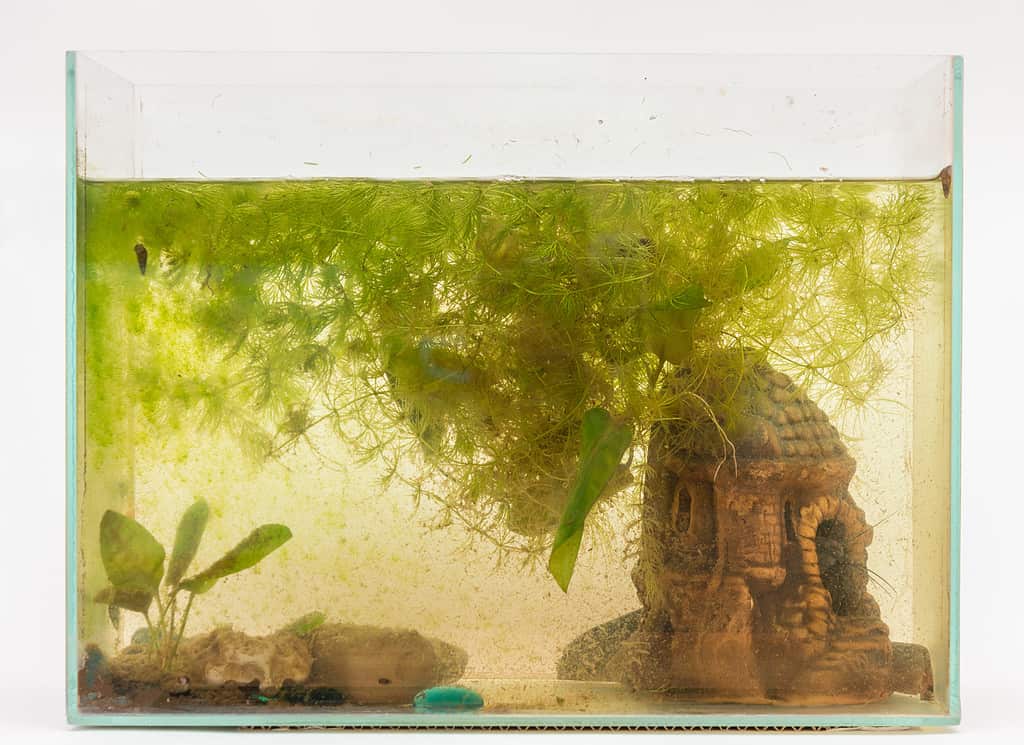
Brown diatom algae is usually quite soft, and many sea creatures enjoy snacking on it.
©Madhourse/iStock via Getty Images
Before you can actually start to get rid of algae in your fish tank, you have to first understand what you’re dealing with. Algae come in many shapes and sizes, and each kind of algae has its own set of specifications. So, here are some of the most common types of algae you’ll likely encounter, as well as a bit about each.
Green Algae
Appearance: Typically green and can be seen in various forms, such as spots on surfaces or floating in the water.
Conditions Favoring Growth: Excess light and nutrients, particularly nitrate and phosphate.
Control Measures: Reduce light exposure, manage nutrient levels, and introduce algae-eating species.
Brown Algae (Diatoms)
Appearance: Brown, slimy film typically covering aquarium glass, decorations, and substrate.
Conditions Favoring Growth: High silicate levels, often in newly established tanks.
Control Measures: Regular cleaning and water changes, using silicate-absorbing media in the filter.
Blue-green Algae (Cyanobacteria)
Appearance: It may appear as blue-green, green, red, or purple slimy sheets covering tank surfaces.
Conditions Favoring Growth: Poor water quality with high organic waste, light, and nutrients.
Control Measures: Improve water quality, reduce light, and manually remove visible patches.
Red Algae (Brush Algae)
Appearance: Often appears as dark red or black tufts that resemble brushes, the red from pigments known as phycobiliproteins
Conditions Favoring Growth: Stable tank conditions with high light and nutrients.
Control Measures: Reducing light exposure, manually removing affected areas, and introducing algae-eating species.
Green Spot Algae
Appearance: Hard green spots are typically found on aquarium glass and slow-growing plants.
Conditions Favoring Growth: High light and low phosphate levels.
Control Measures: Adjusting phosphate levels, reducing light exposure, and manual removal.
Getting Rid of Algae in a Fish Tank

Algae can cause your fish tank to appear murky and dirty.
©Acraveinza/Shutterstock.com
Once you’ve determined what kind of algae you’re dealing with (even if it’s a combination of one or more types), you’re able to successfully narrow down your next course of action. In the following sections, we’ll be breaking down five actionable plans to greatly reduce the amount of algae that is growing in your fish tank.
Balance Your Lighting
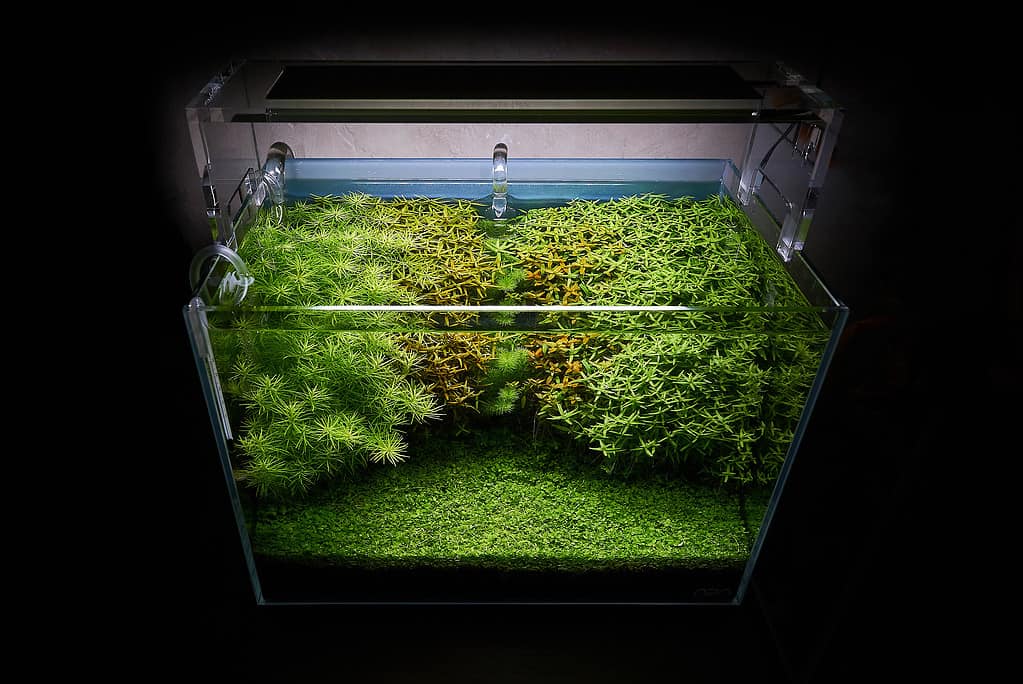
Algae greatly enjoy excess light, so reducing it could be a good idea.
©ComR78/iStock via Getty Images
Our first way, which is also one of the most highly recommended, is a reduction of light. If you have plants in your aquarium, which is likely, they don’t need more than eight hours of light each day. If you don’t have any plants, then your tank needs even less light than that! In fact, your fish would be content with a few hours of light a day. Sometimes, if an algae breakout is particularly severe, it can be a good idea to conduct what is called a “blackout” and turn off the lights for several days at a time.
The good news is that this reduction of light will likely have minimal impact on your fish and plants. While it will be pretty detrimental to the growing algae, the other creatures living in your tank should be feeling A-OK. Another benefit to this is that it’s a low-effort fix, and it could even save you money (electric bills are crazy these days)!
Regular Tank Maintenance

Regular cleaning of the tank is an excellent way to keep algae levels at bay.
©Dmytro Varavin/iStock via Getty Images
Algae, as we’ve established, thrive on the nutrients found in things like detritus and uneaten food. If you want to get rid of algae in your fish tank, then it’s highly important to take regular cleaning seriously. Not only will it mitigate the algae growth, but it’s also something that your fish will be grateful for.
When uneaten food and detritus begin decaying, they release things like ammonia, nitrite, and nitrate. Elevated levels of substances like these will not only cause algae to bloom, but it will also lead to eventual harmful imbalances in the ecosystem of your aquarium.
These are some things you can do on a regular basis to help combat this:
- Using a gravel vacuum to remove waste and uneaten food, especially in hard-to-reach places.
- Scrubbing the walls of the tank and any decorations inside of it to remove algae spores.
- Regularly pruning dead or algae-infected leaves from your aquarium plants.
- Trying to avoid overfeeding your fish, giving them only the amount of food that you’ll know they will consume within a few minutes of time.
Water Changing/Filtration
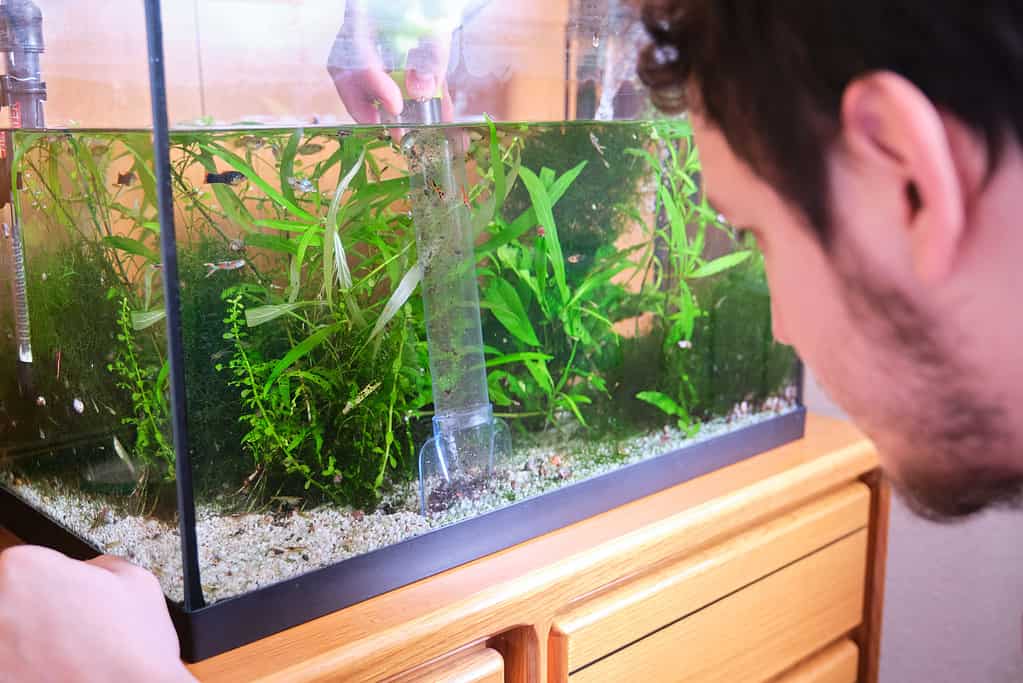
Not having periodic water changes can lead to extreme algae growth.
©Ladanifer/iStock via Getty Images
Changing the water in your tank on a regular basis helps to deter the growth of algae by removing the waste and toxins that accumulate within that water over time. Algae feed off of the growth of substances in your water, so without water changes, you’re effectively building a perfect environment for algae to thrive.
It’s important that whatever kind of filtration system you choose is one that suits the type of aquarium you have. It needs to be capable of handling the load of nitrates and phosphates that it will inevitably need to sift through. Once you’ve chosen a filtration method, be that mechanical or chemical, it’s important that you follow that filter’s particular instructions. Clean and maintain it regularly, and look out for any potential disruptions in the flow rate or filtration process.
Using Live Plants
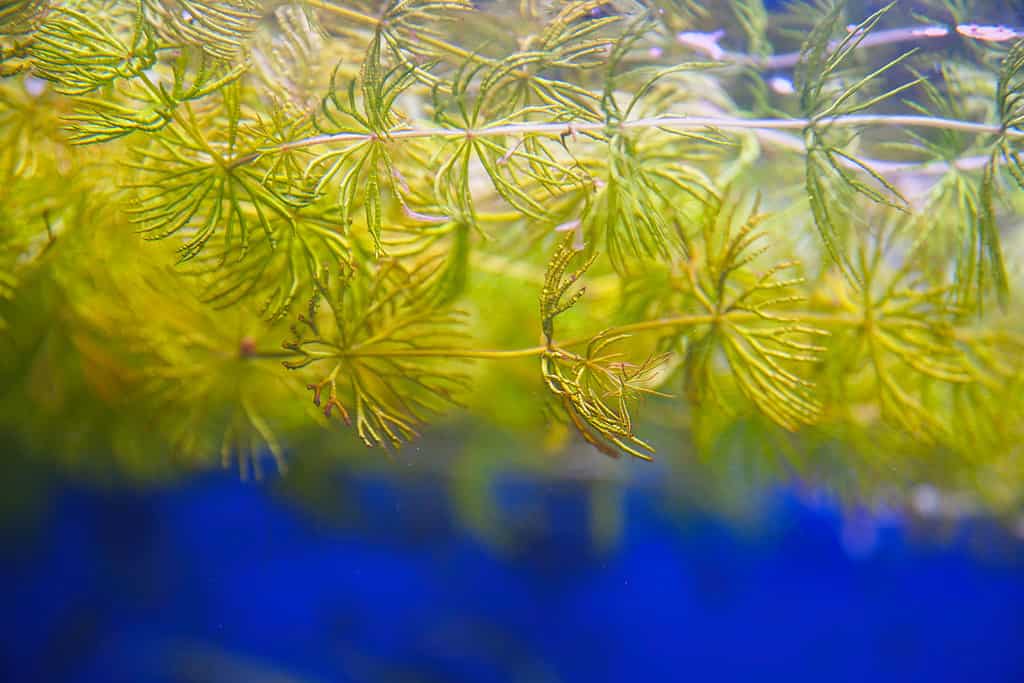
Since the hornwort grows so quickly and requires so much energy to do so, it often beats out any algae in nutrient consumption.
©Pro2sound/iStock via Getty Images
So far, we’ve talked about getting rid of algae in your fish tank by removing things such as debris, old water, and light. But now, we’ll be introducing some things into the tank as opposed to taking things out. Integrating live plants into your tank is a natural way to fight algae growth. Plants and algae often fight for the same resources, so when plants absorb them, there’s none left for the algae to feed on. Here’s a list of some such plants, with a few brief words of description:
- Java Moss: This versatile plant grows in many conditions. It effectively takes away the nutrients that algae vyes for.
- Anubias: The tough leaves that this plant possesses don’t let algae grow on them easily. They also thrive in shaded areas, making them optimal for controlling algae growth!
- Hornwort: Hornwort is a floating plant that grows rapidly, absorbing a large amount of nutrients from the water in the process.
- Water Lettuce: Another floating plant, this limits light penetration into the aquarium as well as absorbs nutrients from the water, making it difficult for algae to access what it needs.
- Water Sprite: These plants are known for their high nutritional uptake, which can make them a good solution for controlling the growth of algae.
Introducing Algae Eaters
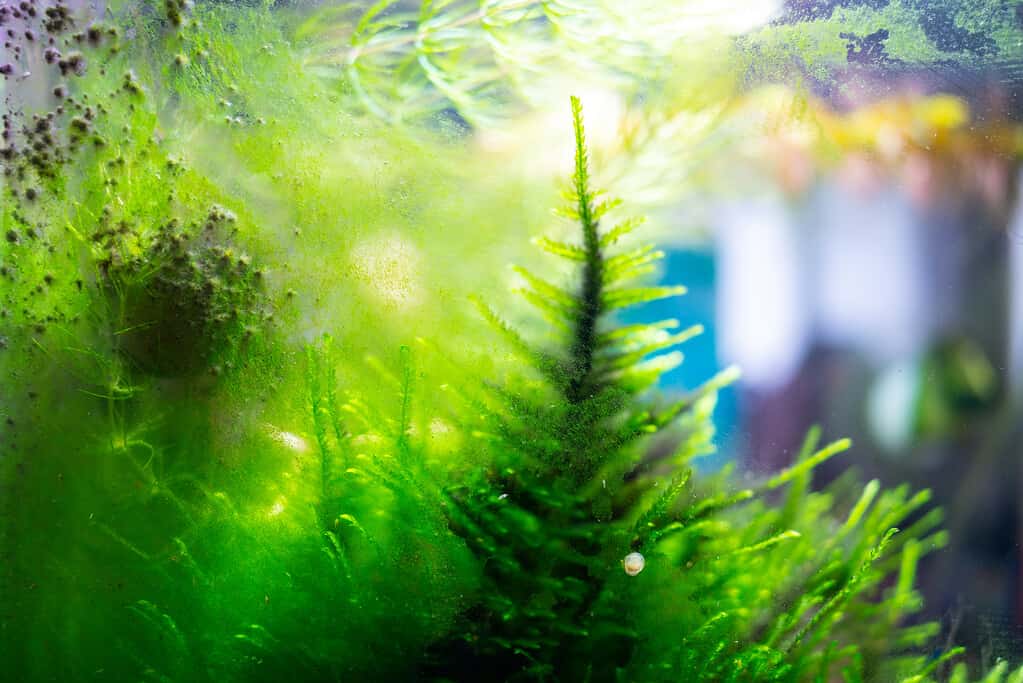
Why bother removing algae when you can just have a fish that does the cleaning for you?
©Staras/iStock via Getty Images
Now you know that there are plants that can fight off algae, but what about algae-eating fish? These fish (and invertebrates) can get rid of algae in a fish tank by feeding on it! It’s a double whammy, you get rid of your algae, and the creatures get a delicious treat.
It’s important, though, that you make sure that the existing creatures in your tank are compatible with the algae eaters you introduce. It was their home first, after all. If you think you would like to have some more company in the tank, here are some solid recommendations:
- Plecostomus: Plecos are popular algae eaters because they consume large quantities of algae at a time. That being said, they grow to be quite large and definitely require a spacious tank to thrive.
- Otocinclus Catfish: These small fish are great at eating algae, especially the soft, green variety.
- Siamese Algae Eater: These fish don’t discriminate when it comes to algae-eating! They consume many varieties of algae, including tough black algae.
- Amano Shrimp: These tiny shrimp are able to get to the hard-to-reach areas of the tank, and they don’t mind snacking on leftover food particles, either!
- Nerite Snail: These snails love to graze on algae as they passively go about their day. As a bonus, they usually come in many unique colors and patterns!
The photo featured at the top of this post is © Aleksandrkozak/Shutterstock.com
Thank you for reading! Have some feedback for us? Contact the AZ Animals editorial team.






